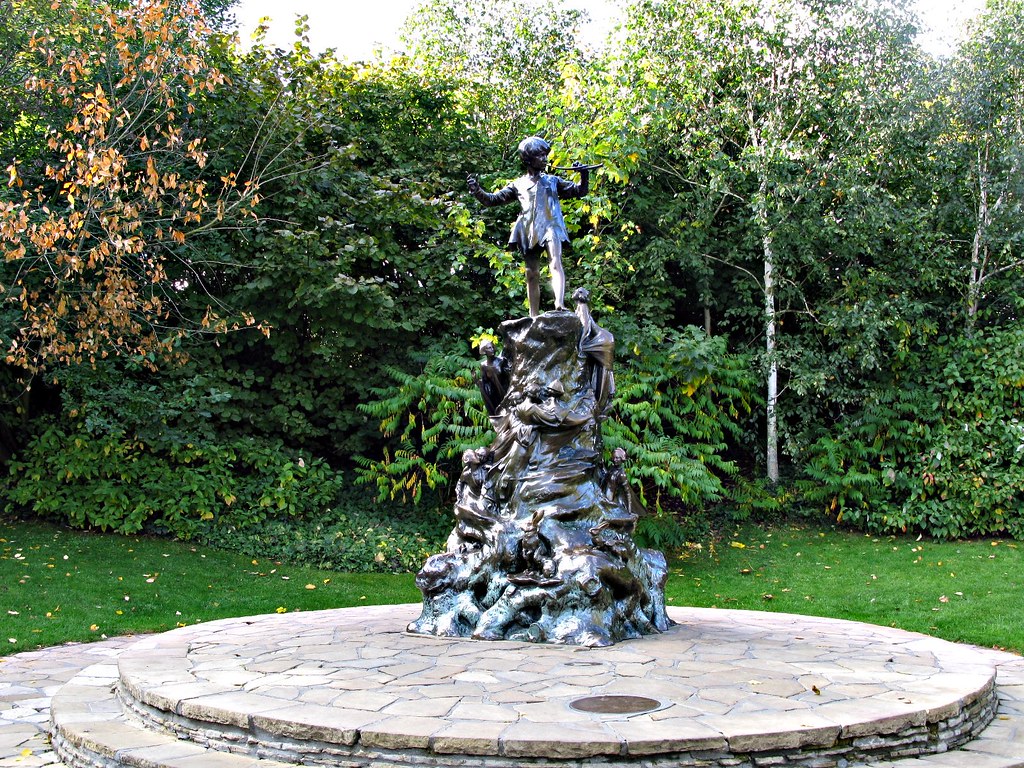The beauty and attractions of a park get highly enhanced if it has beautiful, well-crafted statues that visitors can admire. Moreover, the statues should be big and heavy to prevent them from being stolen. Kensington Gardens, in the heart of Hyde Park presents beautiful landmarks through its statuary that is worth seeing and appreciating. A walk through the park will reveal the following masterpieces.
The Peter Pan Statue
M. Barrie’s inspiration for creating Peter Pan had originated in the park as he lived close by. He was also the motivating force for getting the statue made and for installing it at the exact spot where his little white bird landed after flying out of Peter Pan’s nursery. The statue is located to the west of the Long Water and it is made in bronze depicting squirrels, rabbits, mice and fairies climbing up a life-sized figurine of Peter Pan. Visitors admiring the statue can also get a personal call back from Peter Pan if they swipe their phone on the nearby plaque.
Henry Moore’s Arch
This is a beautiful, admirable sculpture near the water in Kensington Gardens that is appreciated by all visitors to the park. It is made from seven travertine Roman stones and is six metres high weighing a massive 37 tonnes. The Arch by Henry Moore was erected in 1945 but it had to be disassembled in 1996 as a structural instability was noticed and the statue had to be provided with a new internal skeleton of stainless steel doweling. Its creator was Henry Moore, a Yorkshire man and career sculptor, who had commented that he had become rich and that had he been born as rich as he had become, he would not have pursued his career but simply relaxed in the South of France, enjoying the sun. Visitors can find his signature Madonna shape in the mouth of the arch.
Golden Albert
Dedicated to Queen Victoria’s love for her husband Prince Albert, who died from typhoid fever at the young age of 42, the Albert Memorial commemorates his death and is located on Albert Memorial Road. It exemplifies high-Victorian, Gothic extravaganza and also signifies royal love. At the base of this statue, you can see a frieze that denotes some of Prince Albert’s enthusiasms including a passion for sex. It is believed that Prince Albert used to keep his wife, Queen Victoria, constantly pregnant as he did not want her to become too preoccupied with her royal duties, resulting in her begetting nineteen children, which is not an easy achievement.
Guests at The Montcalm Brewery London city hotel get the advantage of being located close to Kensington Gardens and as such they can easily see these statues.
Queen Anne’s Alcove
Created by Sir Christopher Wren in 1705, this habitable monument was built on the boundary of the Queen’s formal south garden against the park wall at Dial Walk. Just below the roof you can see Queen Anne’s coat of Arms. In 1867, the entire Queen Anne’s Alcove monument was moved by a London builder named Mr Cowley at his own expense to a location near Lancaster Gate as he thought that it was unsightly and presented ‘a resort for undesirable persons’. At its present location, it can be visited from dawn until dusk and it presents a curved oak bench where you can enjoy a daytime nap under a dependable rain cover.
If you are visiting London, it would be ideal to stay in a hotel central London as this area is home to most attractions of the city and other places of interest such as business offices, restaurants and shopping districts.
Physical Energy
Designed by C. G. Watts with the purpose of commemorating Cecil Rhodes, the diamond miner and founder of old Rhodesia, this is a massive monument made from brass and rock. It was another addition to the statuary of Kensington Gardens which had gained the reputation of being something of a statue garden for honouring the nation’s heroes. This larger than life statue has, over the years, become famous and is known as the horse with no balls. If you visit the Kensington Gardens you can see that this is true and there are various theories regarding this phenomenon, one of which is that Queen Victoria would have been frightened to see balls of that size. Another theory is that they were vulnerable to theft.
The Bandstand
Located to the south of the Round Pond in Kensington Gardens and designed in Regency style, the bandstand has an ogee roof that is supported by eight delicate iron columns. It gives the appearance of being a hat gathering up ribbons. The permission for playing music in the gardens was given by Queen Victoria but the Archbishop of Canterbury thought otherwise and felt that it would be unseemly to play music in the gardens. The Keeper of the Privy Purse felt that working people did not need band concerts. As such, there has been no activity in the band stand over the years and it has remained quiet most of the time. However, according to one resident, a brass band from Knightsbridge barracks played here twice a day for fifteen minutes.
Elfin Oak
The Elfin Oak statue was sculpted out from the trunk of an ancient oak tree that had originally been growing in Richmond Park. It had been neglected for many years and also suffered damage due to misuse by children who used to clamber up it. The sculptor of the statue, Spike Milligan, worked hard for raising money to be used for its restoration. Moreover, he used to spend his Sunday afternoons giving the elves fresh coats of paint by doing the repainting work himself. It was given a protective ring of metal railings and declared a Grade II listed structure.



